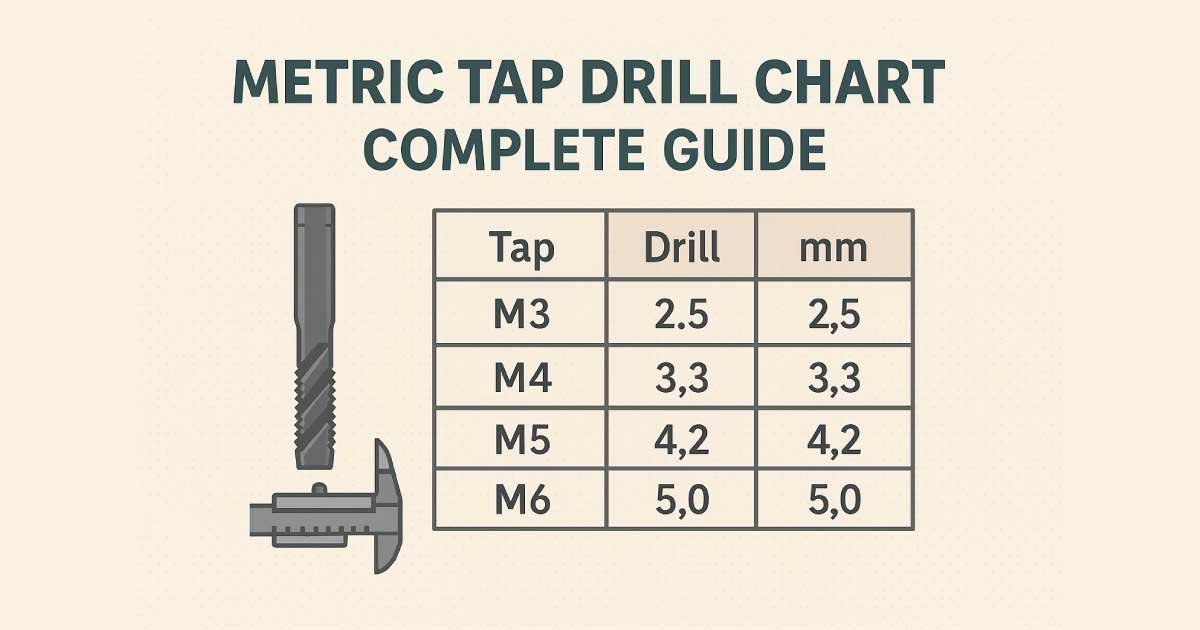When it comes to threading holes in metal, plastic, or other materials, knowing the right tap drill size is essential. A metric tap drill chart is your go-to reference for selecting the proper drill bit before tapping a hole. Using the wrong size can result in weak threads, stripped bolts, or damaged materials.
In this guide, we’ll break down what a metric tap drill chart is, how to use it, and provide a detailed chart for quick reference in your projects.
What is a Tap Drill?
A tap drill is the drill bit used to create a hole that will later be threaded with a tap. The hole size must match the screw or bolt you intend to insert so that threads are strong and precise.
Key points:
Too small → Tap may break or threads may strip
Too large → Threads will be loose and weak
Correct size → Ensures maximum strength and precision
Understanding Metric Tap Sizes
Metric taps are identified by:
Nominal Diameter – The outside diameter of the screw (e.g., M6 = 6 mm)
Pitch – Distance between threads in millimeters (e.g., M6 x 1.0 → 1 mm pitch)
Tap Type – Taper, plug, or bottoming taps
A metric tap drill chart combines these values to give the exact drill size for each screw size.
How to Use a Metric Tap Drill Chart
Find the screw size (e.g., M6)
Check the pitch (standard or fine thread)
Use the chart to determine the drill bit diameter
Formula to calculate tap drill (approximate):
Tap Drill=Nominal Diameter−Pitch\text{Tap Drill} = \text{Nominal Diameter} – \text{Pitch}
Example: For M6 x 1.0 → 6 mm – 1 mm = 5 mm drill
Metric Tap Drill Chart
Here’s a quick reference chart for standard metric screws:
| Metric Size | Pitch (mm) | Drill Size (mm) | Comments |
|---|---|---|---|
| M1.6 | 0.35 | 1.25 | Micro screws |
| M2 | 0.4 | 1.6 | Small electronics |
| M2.5 | 0.45 | 2.05 | Light machinery |
| M3 | 0.5 | 2.5 | Standard screws |
| M3.5 | 0.6 | 2.9 | Electronics & small assemblies |
| M4 | 0.7 | 3.3 | Woodworking & machinery |
| M5 | 0.8 | 4.2 | General mechanical |
| M6 | 1.0 | 5.0 | Furniture & automotive |
| M8 | 1.25 | 6.75 | Heavy-duty |
| M10 | 1.5 | 8.5 | Structural |
| M12 | 1.75 | 10.25 | Large machinery |
| M16 | 2.0 | 14.0 | Industrial applications |
| M20 | 2.5 | 17.5 | High load |
Note: Drill sizes may vary slightly depending on material hardness. Always check manufacturer recommendations.
Also Read:
Tips for Using Metric Tap Drill Sizes
Always drill straight – Misaligned holes can ruin threads
Use cutting fluid – Reduces friction and extends tap life
Tap carefully – Apply even pressure and back off occasionally to clear chips
Check thread fit – Test with a bolt before final assembly
Common Applications
M3–M6 screws → Electronics, furniture, small machinery
M8–M12 screws → Automotive, metal fabrication, DIY heavy-duty projects
M16–M20 screws → Industrial equipment, structural assemblies
Advantages of Using a Metric Tap Drill Chart
Saves time by eliminating trial and error
Reduces risk of damaged threads
Ensures strong and secure screw connections
Useful for machinists, engineers, and DIY enthusiasts
Also Read:
Final Thoughts
A metric tap drill chart is a must-have reference for any project involving threaded holes. Knowing the correct drill size ensures your screws and bolts fit perfectly, providing strength and precision. Keep a chart handy in your workshop, and you’ll avoid common tapping mistakes, saving time, effort, and material.
With this chart, you can confidently drill and tap holes for anything from electronics to heavy machinery, ensuring your projects are built to last.

